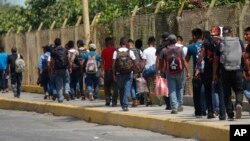VOA's Patsy Widakuswara at the White House, and Aline Barros and Eugenia Sagastume contributed to this report.
As the U.S. attempts to strike an asylum deal with Guatemala, many of the Central American country's own rural residents continue to flee persecution at alarming rates.
President Donald Trump told VOA on Tuesday that the U.S. was "close" to reaching a safe third-country agreement with Guatemala.
According to the United Nations Refugee Agency (UNHCR), Guatemalans accounted for the second-highest number of U.S. asylum applications in 2018 (31,000), second only to El Salvador. That same year, an additional 86,900 Guatemalans were awaiting decisions on pending claims.
Ninette Kelley, UNHCR New York office director, said a struggle with “law and order” continues to plague the Northern Triangle, a region that includes Guatemala, Honduras and El Salvador.
“There are very gripping accounts of situations where neighborhoods are controlled by rival gangs, and where the choice for a young male is, you either join a gang and murder others, or you be murdered yourself,” Kelley told VOA. “For a young woman, it can be conscripted into trafficking and sexual abuse.”
In a pair of June 17 tweets addressing a possible asylum “fix” and a premature ICE raid announcement, President Donald Trump declared, “Guatemala is getting ready to sign a Safe-Third [Country] Agreement,” confirming VOA’s initial reporting on ongoing U.S.-Guatemala bilateral discussions.
On Saturday, Trump tweeted again, announcing a delay of mass deportations “to see if the Democrats and Republicans can get together and work out a solution to the Asylum and Loophole problems at the Southern Border.”
According to a copy of an unsigned draft agreement obtained by VOA and presented by a U.S. delegation to Guatemala on June 13, a “safe third country” deal between the two countries would effectively block Salvadoran and Honduran nationals from seeking asylum in the U.S. With few exceptions, asylum-seekers would have no choice but to file their claims in Guatemala.
The discussions continue after the State Department announced foreign aid cuts to Guatemala, El Salvador and Honduras on June 17.
‘Social and economic’ consequences
The proposed asylum deal by the U.S. is part of a larger push aimed at curbing the current Central American migration crisis at the U.S. southern border. Mexico has indicated a willingness to sign a regional asylum pact with countries like Guatemala, Panama and Brazil, if all other efforts fail.
But experts warn such a plan, if signed, would result in significant consequences for Guatemala, where roughly six in 10 residents live below the national poverty line, according to World Bank Group data.
High homicide rates and extreme poverty, including food insecurity, are among the central forces driving Guatemalans north.
According to U.S. Customs and Border Protection, more Guatemalans have been apprehended along the U.S. Southwest border in the current fiscal year than nationals from any other country. Since last October, 1% of Guatemala’s 17 million residents have migrated to the U.S., according to Acting Homeland Security Secretary Kevin McAleenan.
"If here in Guatemala we lack the social and economic conditions to provide work and development opportunities to our own residents, we are much less capable of receiving a wave of immigrants — large, medium or small — that come here with those same humanitarian necessities and requirements,” Giulio Talamonti, a security and political analyst and a professor at Mariano Gálvez University in Guatemala City, told VOA’s Latin America Division on June 12.
“The only thing this could bring us is increased levels of poverty, unemployment, a lack of opportunities and of course — consequently, in many cases — even higher levels of insecurity and violence,” Talamonti said.
Assessing grounds for asylum
Groups intent on restricting Central Americans’ ability to seek asylum in the U.S., like the Center for Immigration Studies (CIS), argue regional countries should do more to help curb and discourage Central American migration to the U.S. border.
“It’s not fair for us to simply dump all these failed asylum-seekers back on Mexico,” CIS’ director of policy studies, Jessica Vaughan, told VOA. “If all the countries in North America and Central America work together, then the migration that’s been occurring recently can be better controlled.”
Fernando Chang-Muy, a professor of refugee law and policy at the University of Pennsylvania, explained that for any asylum agreement to work, several assumptions must be addressed, including whether the country in question is actually safe and equipped with sufficient “trained, competent” asylum officers.
“Do they have the expertise — the emotional intelligence — to listen to people, to assess whether this person looks credible, because they have no other evidence that the gangs are after them or that the gangs are extorting them, or any of the grounds (for asylum)?” Chang-Muy told VOA.
“Often, it’s just your story, your trauma, trying to persuade an asylum officer or an immigration judge that you truly do have a well-founded fear of persecution based on race, religion, nationality, social group or political opinion,” he said.
A nationwide poll conducted by CID-Gallup Latinoamérica ahead of Guatemala’s elections earlier this month showed residents remain mostly concerned about poverty, violence and corruption.
In the nation’s capital, some locals worry an asylum plan could make those problems worse.
“The situation in our country is very hard,” Jorge Fuentes, a resident from Guatemala City, told VOA. “(When) people come from outside, they come to commit crimes. They rob and form gangs.”
Another Guatemala City resident told VOA, “They (migrants) only cause harm to everyone,” citing the country's issues with extreme poverty. “Nothing good can come out of it.”







